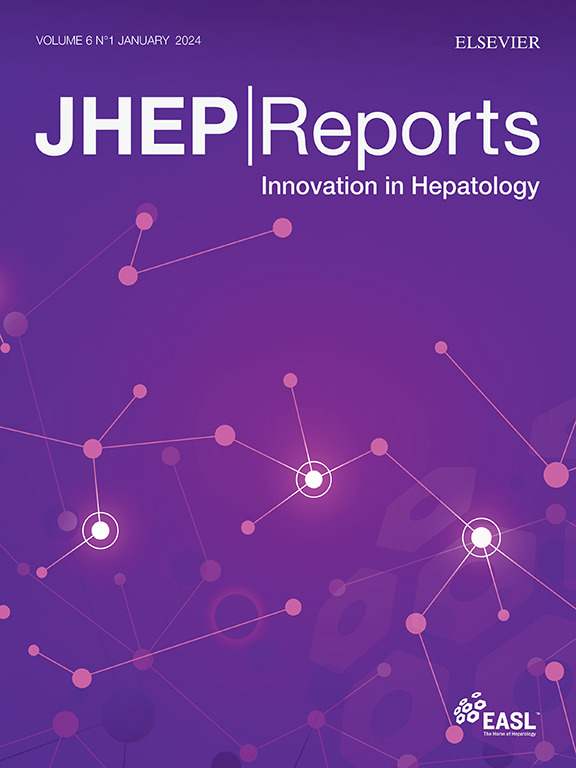A patient-derived HCC spheroid system to model the tumor microenvironment and treatment response
IF 9.5
1区 医学
Q1 GASTROENTEROLOGY & HEPATOLOGY
引用次数: 0
Abstract
Background & Aims
Hepatocellular carcinoma (HCC) is the third-leading and fastest rising cause of cancer-related death worldwide. The discovery and preclinical development of compounds targeting HCC are hampered by the absence of authentic tractable systems recapitulating the heterogeneity of HCC tumors in patients and the tumor microenvironment (TME).
Methods
We established a novel and simple patient-derived multicellular tumor spheroid model based on clinical HCC tumor tissues, processed using enzymatic and mechanical dissociation. After quality controls, 22 HCC tissues and 17 HCC sera were selected for tumor spheroid generation and perturbation studies. Cells were grown in 3D in optimized medium in the presence of patient serum. Characterization of the tumor spheroid cell populations was performed by flow cytometry, immunohistochemistry (IHC), and functional assays. As a proof of concept, we treated patient-derived spheroids with FDA-approved anti-HCC compounds.
Results
The model was successfully established independently from cancer etiology and grade from 22 HCC tissues. The use of serum from patients with HCC was essential for tumor spheroid generation, TME function, and maintenance of cell viability. The tumor spheroids comprised the main cell compartments, including epithelial cancer cells, as well as all major cell populations of the TME [i.e. cancer-associated fibroblasts (CAFs), macrophages, T cells, and endothelial cells]. Tumor spheroids reflected HCC heterogeneity, including variability in cell type proportions and TME, and mimicked the original tumor features. Moreover, differential responses to FDA-approved anti-HCC drugs were observed between the donors, as observed in patients.
Conclusions
This patient HCC serum-tumor spheroid model provides novel opportunities for drug discovery and development as well as mechanism-of-action studies including compounds targeting the TME. This model will likely contribute to improve the therapeutic outcomes for patients with HCC.
Impact and implications:
HCC is a leading and fast-rising cause of cancer-related death worldwide. Despite approval of novel therapies, the outcome of advanced HCC remains unsatisfactory. By developing a novel patient-derived tumor spheroid model recapitulating tumor heterogeneity and microenvironment, we provide new opportunities for HCC drug development and analysis of mechanism of action in authentic patient tissues. The application of the patient-derived tumor spheroids combined with other HCC models will likely contribute to drug development and to improve the outcome of patients with HCC.

一个患者来源的肝细胞癌球体系统来模拟肿瘤微环境和治疗反应。
背景与目的:肝细胞癌(HCC)是全球第三大且增长最快的癌症相关死亡原因。针对HCC的化合物的发现和临床前开发受到缺乏真实的可处理系统的阻碍,这些系统概括了HCC患者肿瘤和肿瘤微环境(TME)的异质性。方法:以临床HCC肿瘤组织为基础,采用酶解和机械解离的方法,建立了一种新型、简单的患者源性多细胞肿瘤球体模型。在质量控制后,选择22个HCC组织和17个HCC血清进行肿瘤球体生成和摄动研究。在优化的培养基中,在患者血清的存在下,细胞在3D中生长。通过流式细胞术、免疫组织化学(IHC)和功能测定对肿瘤球状细胞群进行表征。作为概念验证,我们用fda批准的抗hcc化合物治疗患者源性球体。结果:成功建立了独立于肝癌病因和分级的肝癌模型。使用HCC患者的血清对于肿瘤球体生成、TME功能和维持细胞活力至关重要。肿瘤球体包括主要的细胞区室,包括上皮癌细胞,以及TME的所有主要细胞群[即癌症相关成纤维细胞(CAFs)、巨噬细胞、T细胞和内皮细胞]。肿瘤球体反映了HCC的异质性,包括细胞类型比例和TME的可变性,并模拟了原始肿瘤特征。此外,在供体之间观察到对fda批准的抗hcc药物的不同反应,在患者中也观察到。结论:这种HCC患者血清-肿瘤球体模型为药物发现和开发以及包括靶向TME的化合物在内的作用机制研究提供了新的机会。该模型可能有助于改善HCC患者的治疗效果。影响和启示:HCC是世界范围内癌症相关死亡的主要和快速上升的原因。尽管新疗法获得批准,但晚期HCC的预后仍不令人满意。通过建立一种新的患者源性肿瘤球体模型,再现肿瘤异质性和微环境,我们为HCC药物开发和分析在真实患者组织中的作用机制提供了新的机会。患者源性肿瘤球体与其他HCC模型的联合应用可能有助于药物开发并改善HCC患者的预后。
本文章由计算机程序翻译,如有差异,请以英文原文为准。
求助全文
约1分钟内获得全文
求助全文
来源期刊

JHEP Reports
GASTROENTEROLOGY & HEPATOLOGY-
CiteScore
12.40
自引率
2.40%
发文量
161
审稿时长
36 days
期刊介绍:
JHEP Reports is an open access journal that is affiliated with the European Association for the Study of the Liver (EASL). It serves as a companion journal to the highly respected Journal of Hepatology.
The primary objective of JHEP Reports is to publish original papers and reviews that contribute to the advancement of knowledge in the field of liver diseases. The journal covers a wide range of topics, including basic, translational, and clinical research. It also focuses on global issues in hepatology, with particular emphasis on areas such as clinical trials, novel diagnostics, precision medicine and therapeutics, cancer research, cellular and molecular studies, artificial intelligence, microbiome research, epidemiology, and cutting-edge technologies.
In summary, JHEP Reports is dedicated to promoting scientific discoveries and innovations in liver diseases through the publication of high-quality research papers and reviews covering various aspects of hepatology.
 求助内容:
求助内容: 应助结果提醒方式:
应助结果提醒方式:


